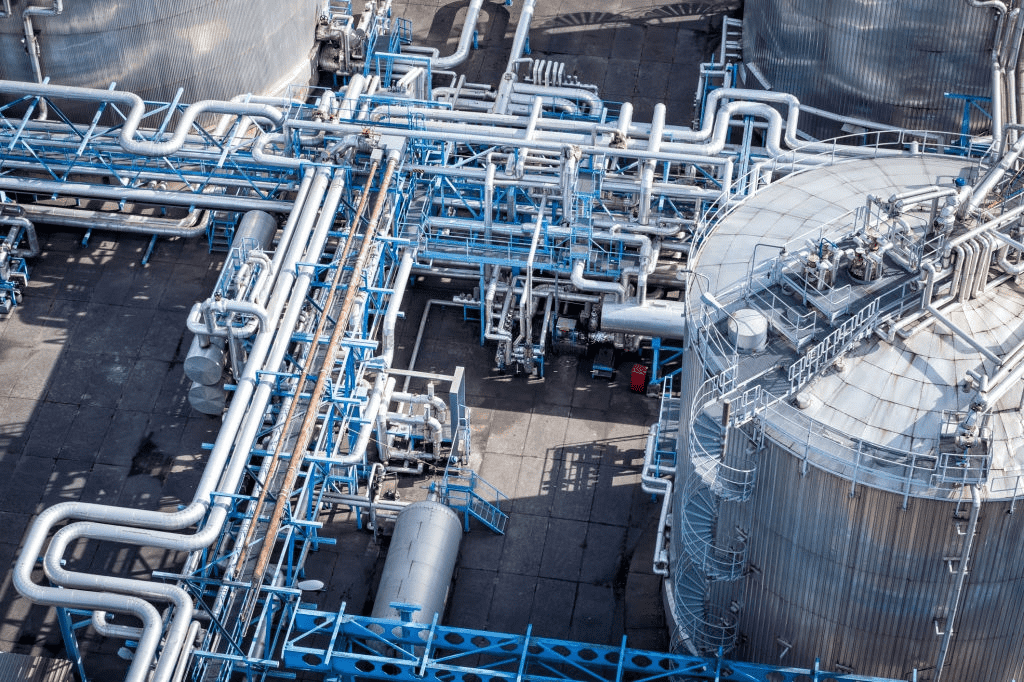Favorable pricing due to a recent boost in domestic production and widespread availability has led to a rise in the popularity of natural gas. Many facilities rely on natural gas as the fuel to make materials and chemicals. Thanks to its current affordability and accessibility, entities from large power generation plants to industrial manufacturers alike use natural gas to power their facilities.
Natural gas is a type of fossil energy that formed millions and of years ago, found beneath the earth’s surface. When it is found in large cracks between layers of rock, it’s called conventional natural gas. Alternatively, natural gas can also be found in small spaces in sedimentary rocks like shale and sandstone.
Natural gas found in these spaces is often called shale or unconventional natural gas and can only be freed through fracking. North America has substantial deposits of shale gas that can be readily released to the surface and then sent directly into gathering pipelines that feed processing plants. Within the past decade, natural gas production in the United States has increased, encouraging its prevalent use.
Purchasing natural gas for your business involves understanding a few key components like what drives the demand and impacts the natural gas price. To get a thorough understanding of what natural gas will cost, understanding risk factors like a swing as well as costs and fees associated with transmission from either Citygate or burner points are imperative. Consider each of these variables carefully as you examine natural gas bids and compare providers.
Natural Gas Pricing In The U.S.
Natural gas pricing in the U.S. is based on supply and demand. Surges in the supply translate to notable drops in price, and the reverse is also true.
To deliver natural gas to the consumer, it is collected from either the wellhead or shale site and piped for processing and storage. From storage, it is sent directly to the consumer via pipeline. The natural limitations and delays associated with such a large, and complex natural gas infrastructure can influence product availability and price. There are two primary sets of concerns: the supply side and the demand side.
On the supply side, there are three factors that heavily influence price:
- Total natural gas production: As domestic natural gas production has swelled over the last 10-15 years, prices have decreased and continue to remain less volatile. This has made it an attractive option for many consumers and increased its adoption.
- Amount of natural gas in storage: Natural gas in underground storage fields helps buffer the supply by allowing providers to readily meet peak demand. Storage absorbs excess production when demand is low and supplements the supply when production and imports cannot satisfy the demand.
From April to October, underground storage deposits increase in preparation for the winter demand that comes from heating requirements. During the winter, the supply is drawn down.
- Imports and Exports: Most of the natural gas used in the U.S. is produced here, except for some pipeline imports from Canada and Mexico, and shipments of LNG (liquefied natural gas).
On the demand side, there are also three main sets of concerns:
- The weather: As severe weather becomes increasingly frequent, it’s important to consider the effect that it has on natural gas prices. Hurricanes, floods, and natural disasters can interrupt the natural gas supply and cause prices to spike temporarily.
In the winter, residential and commercial energy customers use natural gas for heating, increasing demand and thereby raising prices during colder months. In the summer, power companies use natural gas to generate electricity for air conditioning. Summer demand can also influence the amount of natural gas deposited in storage in preparation for the winter, indirectly affecting winter prices, too.
- Economic Growth: As the preferred fuel for many industrial manufacturers, natural gas demand increases during periods of economic growth. When meeting their own heightened consumer demand, manufacturers require more power to produce more goods.
- Price and availability of other fuels: Some large-volume fuel consumers, like power plants or steel mills, are capable of switching their primary fuel source to the cheapest option, whether it’s natural gas, coal or petroleum. With natural gas’ relatively low, stable prices, some have elected to forgo the ability to switch fuels.
Common Questions About Natural Gas
Understanding a few key natural gas concepts is imperative to know how your natural gas is purchased and supplied. City Gate and burner tip refer to pipeline delivery methods and impact how you are charged. Swing percentage and swing options pertain to your usage and contract requirements. Choosing the best terms in light of your situation can easily save you money. Similarly, mistakes can be quite costly.
Q. What are City Gate and burner tips?
City Gate is the physical place where natural gas is transported to a local distribution company by pipelines. Burner tip gas is at the destination point where the natural gas will be used as fuel.
Q. Which delivery method is better: City Gate or burner tip?
Neither City Gate nor burner tip is better or worse than the other. It’s the same gas, just at a different point, and billed in a different way.
City Gate gas rates will include a fee in addition to your rate to compensate for lost and unaccounted for gas (LUAF) that happens as it travels through the pipeline. A burner tip rate includes an additional, built-in charge to compensate for the LUAF.
To accurately consider City Gate pricing, add 1-3% to the bid to seeing what you would expect from a comparable burner tip quote.
Q. What are the different types of swing percentages?
Swing percentage dictates how much more or less than your monthly contracted quantity of natural gas you can use. It ranges from 0-100% and is typically offered in three options: 0%, 10%, and 100%.
Swing options are most commonly used for purchasing oil, natural gas, and electricity as a way for investors to hedge against price changes and power companies to regulate peak demand.
Q. How do I choose between the swing options?
Selecting a swing option depends on the consistency of your average use and risk tolerance. A manufacturing facility, for example, has a regular production schedule that requires a relatively flat, even natural gas requirement every month. Consequently, this type of user may be a good candidate for a 0% swing.
Other types of users, for example, a condominium association that uses quite a bit more natural gas for heating through the winter months, may not be a good candidate for 0% swing. 100% swing or “full requirements” users are billed the same price for their actual usage, regardless of how it changes every month. These charges are usually billed at a premium compared to lower swing options as natural gas providers shoulder an element of the market risk to compensate for usage fluctuations.
On the other hand, 0% and 10% of swing users may receive a lower natural gas rate but will be subjected to penalties if they go above or below the contracted amount each month. 0% and 10% of swing users under their monthly contracted usage can expect the supplier to sell unused natural gas back to the market and credit the difference to them.
Before selecting a swing option, first, consider your usage. If it’s consistent and predictable, a lower swing percentage may benefit you financially. Secondly, consider your risk tolerance. Although you’ll enjoy a lower up-front price for smaller swing percentages, the penalties for exceeding your contract usage can be substantial.
Increasingly extreme weather, for example, has impacted standard usage each year and will likely continue to do so. Before you commit to a lower swing option, make sure that you can handle the risk associated with these potential variables.
Consult A Professional At Navigate Power
Heightened domestic natural gas production in recent years has made natural gas the stable, affordable fuel of choice for many large-volume users. Businesses of many types, from power plants to industrial manufacturers, rely on natural gas to power their operations.
As the supply of natural gas rises, the market price falls. To smooth out those fluctuations and buffer customers from price shocks, large underground fields are filled during warmer months and depleted by the increased consumption required to heat homes and businesses during the winter. Aside from seasonal demand and production shifts, the economy and pricing parity with other fuels can influence natural gas prices.
There are plenty of options to consider when procuring natural gas for your business. Choosing the ones best situated for your usage can be difficult and time-consuming. For guidance, feel free to reach out to an energy consultant, like Navigate Power.
We can help you compare bids to determine the best utility rates, making sure that you fully understand the implications and total anticipated costs of your contract. We can also help you to evaluate your swing options to find the best gas price in Illinois. Together, we can develop a long-term, sustainable, cost-effective energy management strategy that will meet your needs.
About Navigate Power
Navigate Power is a leading electricity and natural gas consulting firm, headquartered in Chicago, IL. Ranked no. 550 on the 2017 and no. 856 on the 2018 Inc. 5000 list as one of the fastest-growing companies in the nation, Navigate Power continues to expand into new markets nationwide and currently manages over 30,000 commercial energy accounts and over one billion dollars in energy budgets.



